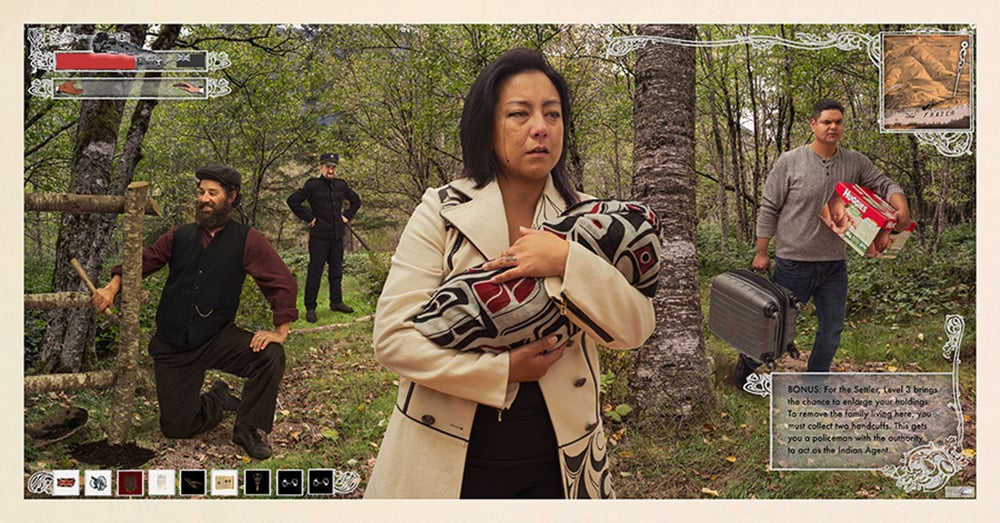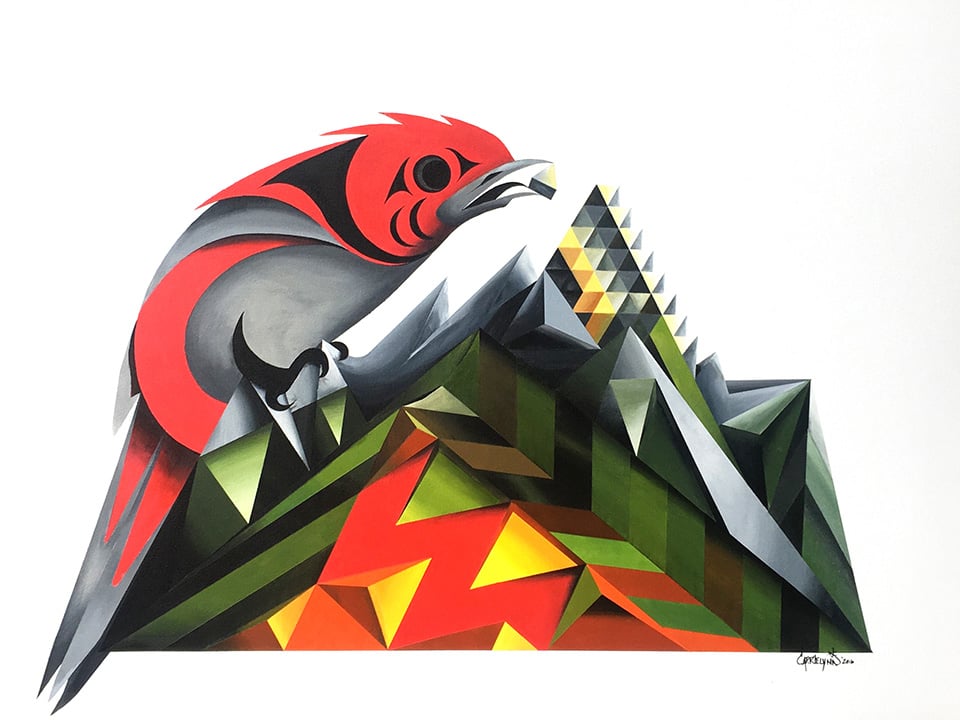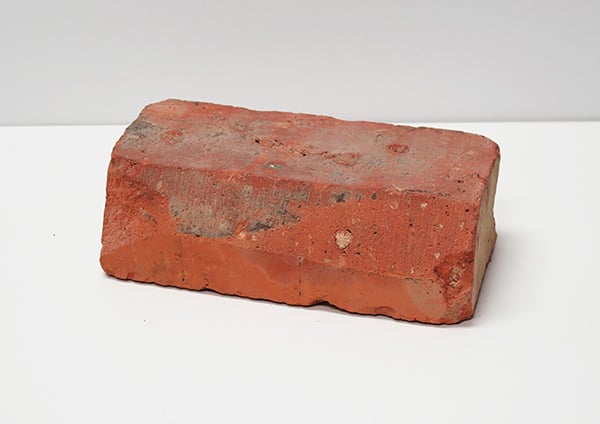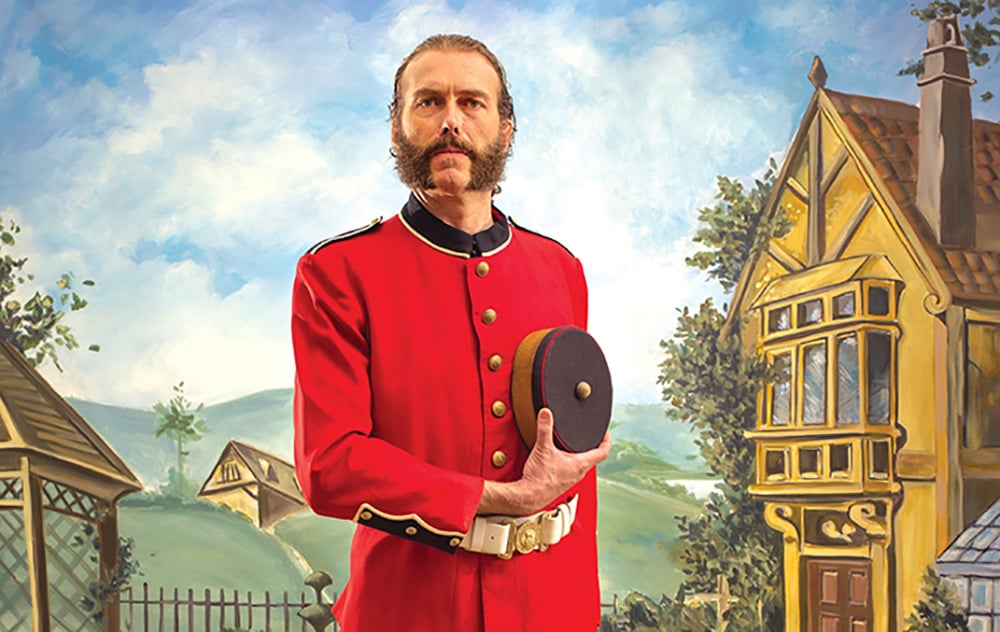“Reconciliation is not an Aboriginal problem, it is a Canadian problem. It involves all of us.”
Inspired by the words of Justice Murray Sinclair, chair of the Truth and Reconciliation Commission, Abbotsford’s The Reach, an award-winning gallery on unceded Stó:lō territory, has kicked off its 2017 winter/spring season with a response to Canada 150, the federal government’s celebration of Confederation.
Four exhibitions exploring decolonization and reconciliation opened on Jan. 26. From the phallic/feminine dichotomy in a stinging nettle to the colonialism inherent in bricks to a portrait of a community healing, the new shows chart varied perspectives by established and emerging Fraser Valley artists.
All four exhibitions challenge audiences to see Canada’s history from a different perspective, including the two feature exhibits — Grand Theft Terra Firma, a photographic installation that questions the familiar narrow version of colonial history, and Sq’éwlets: A Stó:lō-Coast Salish Community in the Fraser River Valley, described as “both an exhibition and a significant online project that results from a major interdisciplinary, cross-cultural collaboration.”
Chief Dalton Silver of the Sumas First Nation opened the night by thanking The Reach for acknowledging the 10,000-year history of the Coast Salish people.
“It wasn’t long ago that many people from this area didn’t even know of our existence,” he said to the gathered crowd. “But there was also a time when the Coast Salish people acknowledged each other as one.” Silver then introduced his Sq’éwlets neighbours, one of several Stó:lō communities to sing and dance a welcome song.
The Reach executive director and curator Laura Schneider spoke of the role museums have played in celebrating mainstream colonial history and downplaying the impact this had on Indigenous communities.
“What events are remembered and how they are characterized has significant bearing on how we understand ourselves collectively and in society,” she said. “We have an obligation to think about who this narrative serves.”
And it seems that community leaders in Abbotsford are ready for the shift toward a different perspective. Coun. Dave Loewen spoke on behalf of the City of Abbotsford. “Exhibitions like this allow our communities to come together and provide a unique opportunity for discussion,” he said at the opening. “They help us to ask questions and address complex issues and open our minds to different perspectives.” Loewen said he hopes this exhibition will sharpen the city’s focus in considering its relationship with First Nations neighbours.
The show runs until May 7.
About the exhibitions
Sq’éwlets: A Stó:lō-Coast Salish Community in the Fraser River Valley
The gallery’s exhibit of community photos and timeline around a significant archaeological partnership between Sq’éwlets and University of British Columbia archaeology professor Michael Blake is just the tip of the iceberg. Diving into the related online resource is like falling down a rabbit hole of images, words and voices exploring what it means to be a Sq’éwlets person and community member today. Both the website and exhibition prominently feature the Halq’eméylem language and share Sq’éwlets’ views on self-representation and ownership of cultural heritage.

Much of the work on the project stemmed from a 25-year collaboration between Chief Clarence Pennier of Sq’éwlets, Blake and researchers at Stó:lō Nation. In 1992, excavations began at Qithyil, a site that included several burial mounds. Community members were concerned about development and other potential encroachments and wanted to ensure this ancestral site was protected.
Current Sq’éwlets Chief Colin Pennier, who spoke at the opening, was a young boy when much of the archaeological work was started. This project would not have happened if people in his community hadn’t been willing to learn and heal, he said. Pennier said he’s watched his community go from a place where few people wanted to be involved in understanding its past and future to one where so many had come and filled the room at The Reach.
“We are asking for understanding and respect,” he said of the incredible resource now online. “We didn’t learn about our own people in school and it is a lot different now that we can share it in our own words.”
From The Reach
“The Sq’éwlets community has played a central role in collaborative community-based archaeology in B.C., and has translated this knowledge into an accessible exhibition and website that address many of the recommendations outlined in the Truth and Reconciliation Commission. This project was achieved with funding from the Virtual Museum of Canada’s Virtual Exhibits investment program... [which] helps Canadian museums and heritage organizations develop virtual exhibits and resources that engage online audiences in Canada’s history and culture.”
Grand Theft Terra Firma: A Game of Imperial Stick up
“Pick your thief and play your part in the crime,” reads the playbook instructions in David Campion and Sandra Shields reframing of the settlement of Canada as a video game-style heist. Their installation, a play on the popular Grand Theft Auto game where players commit violent and immoral acts to get ahead, includes large portrait photos of colonial-era characters who would-be gamers can chose to become — the Miner, the Settler, the Royal Engineer — along with several imagined in-game scenes.

As depicted above, players who chose the Settler avatar can enlarge their holdings by kicking Mary-Jane and her husband off their land. Other images warn players that seeking necessary Stó:lō medicine to relieve voracious mosquito bites could interfere with a player’s prejudice levels. “The caring ways of this family will make you reconsider your notions about their inferiority.”
If your empathy levels get too high, another option is to join the Colonial Theatre, where you can take part in plays about the vanishing noble savage, shedding tears on stage while steeling your resolve to trample Indigenous rights in the field.
Campion and Shields, long-term residents of the tiny community of Deroche in the heart of Stó:lō territory, worked with actors, friends and neighbours to create the elaborate portraits and game scenes in studio.
Campion searched thrift stores for the 19th century costumes, borrowed from the University of Fraser Valley theatre department and even had a couple of outfits sewn. But the Indigenous characters in the scenes are depicted in modern clothes.
“For many mainstream Canadians, this history happened a long time ago,” Campion explains. “Whereas First Nations live the theft. It is a daily reality. Every time they leave their reserves or look at their status cards. Or see development on their land. It’s daily reality. They are reliving that theft.”
From the Reach
“The project pushes the national conversation around reconciliation by using satire and humour as entry points into difficult knowledge. Blending fictional characters with elements drawn from the historical record, the artists create an ambiguous space where audiences are asked to reconsider their relationship to colonial practices.”
Poison, Pattern, Paradigm
Carrielynn Victor (Xemontélót), an artist, fisher, plant harvester and medicines practitioner from Cheam First Nation, told the audience that activism takes various forms. Different personalities bring different types of activism to the fore.

“This is my activism,” she said gesturing to the paintings that make up this, her first solo exhibition.
Victor has two distinct bodies of work in the show. She says her stinging nettle pieces were created to go beyond the binary in gender identity and sexuality. Stinging nettle, a medicinal, nutritious and materially useful plant, also produces male and female flowers. “We can recognize much of who we are in the plant world.”
Her bold acrylic paintings play with geometric forms inspired by patterns found in Coast Salish weaving and design. She fuses ancestral knowledge and a deep connection to her culture with contemporary techniques and styles.
From the Reach
“The works recount aspects of Stó:lō stories and worldview, while simultaneously drawing from her lived experience and our collective immersion in popular culture. [Victor’s] practice considers gender and sexuality, community, interconnectedness, land and sustainability.”
Stretchers, Headers & Footnotes
Spools of slender string line the walls in Lyndl Hall’s installation examining the role of the red brick building in colonial expansion. She calls these mock-ups of a mason’s form line the precursor to the weight of colonialism.
Now based in Calgary, Hall became intrigued by the Clayburn/Kilgard brickworks of the Fraser Valley after first finding out that the small city she was born in, Pietermaritzburg, KwaZulu-Natal, South Africa, had the largest red brick building in the southern hemisphere. For Hall, this grandiose structure symbolized the exported homeland of the colonialists in South Africa. When she realized there were brickworks in the Fraser Valley too, she connected the two together.

From The Reach
“These disparate sites mirror the establishment of British rule through industry, bureaucracy and architecture. Brick is both a literal and figurative building block for an empire fashioned out of the clay of foreign lands. The exhibition, which draws heavily on the archives of The Reach as well as the Pietermaritzburg archives, consists of a series of drawings, a book work, and installation elements that consider the materials that document and stand for the processes of colonization.”
Check out The Reach’s additional programs and events, and the decolonization and reconciliation theme, including a brunch with the artists (Feb. 4, 10:30 a.m.). ![]()
Read more: Indigenous, Rights + Justice















Tyee Commenting Guidelines
Comments that violate guidelines risk being deleted, and violations may result in a temporary or permanent user ban. Maintain the spirit of good conversation to stay in the discussion.
*Please note The Tyee is not a forum for spreading misinformation about COVID-19, denying its existence or minimizing its risk to public health.
Do:
Do not: